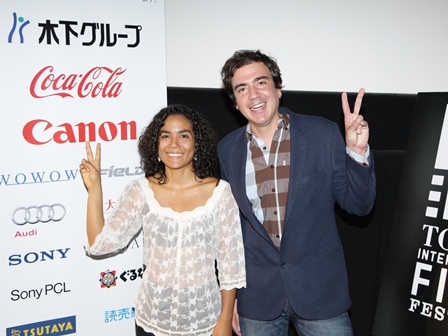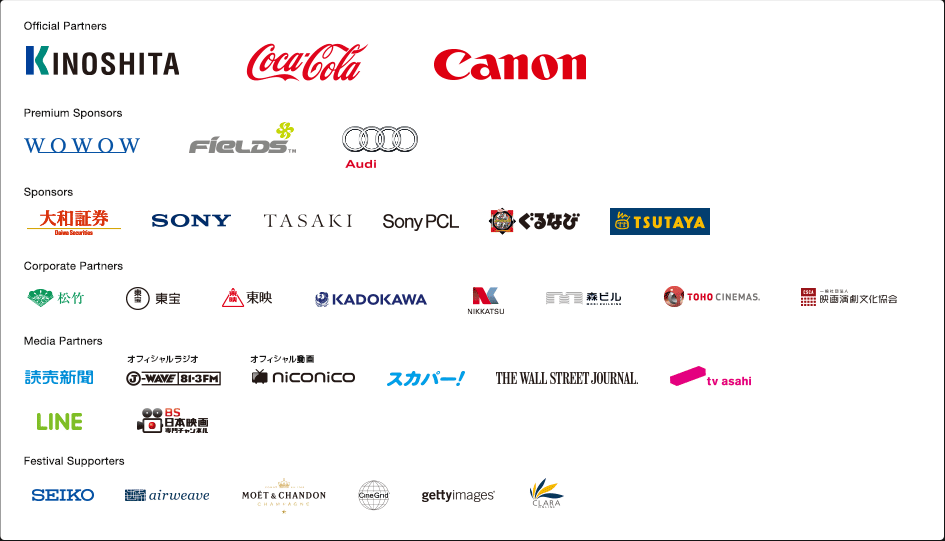Director Oscar Ruiz Navia and producer Gerylee Polanco Uribe came to the Tokyo International Film Festival with their new film, Los Hongos, which is playing in the competition section.

Los Hongos is a celebration of graffiti art and street culture in Cali, Colombia, his hometown. The story follow two friends – Ras, from the poor side of town, his mother deeply religious and concerned for his well-being and Calvin, an art student with divorced parents, who dotes on and takes care of his ailing grandmother. The two drift through the demi-monde of Cali, running afoul of the law, testing their friendship and ultimately, learning a few things about living, friendship, learning from their peers and the older generation and turning difficult issues and roadblocks into positive results. The two main actors, Jovan Alexis Marquinez (Ras) and Calvin Buenaventura Tascón (Calvin) throw their all into their great performances.
Navia explained, “Actually the two main actors weren’t professional actors. We did a very long process casting in different kinds of institutions – like high schools – for about a year and a half. I was doing casting. I was doing interviews – around 700 interviews with different kinds of teenagers. Because I was searching for young guys that could really paint – that could make graffiti. At some point of the project I thought the film was going to be about two geniuses, like Basquiat or something like that. But, fortunately I realized that it wasn’t a good idea or something according to reality. So I changed the project and decided to make a film about two beginners – like, two dreamers. Two guys who want to learn maybe from others more experienced. So, I was just trying to find someone who knew how to paint.”
He added, “I was very lucky to find these two guys. Ras, for example, he’s a skater, he also likes Rastafari culture. And Calvin, for example, he practices parkour. In real life, he’s the son of a punk – an old punk. You can see him in the film, when Calvin goes to the party, he says hello to a very old punk. This is his father in real life. They had so many stories in his life that really, really fed my proposal, my script.”
He added even more about the underground art scene in Cali and about how close to home his casting was.
“About the graffiti scene in Cali – it’s not very big but it’s growing very fast at this moment. Of course, all the people that are in the film – they aren’t professional actors. Not only the graffiti artists, but all the characters. The father is my father. The grandmother is the sister of my grandmother. The mother in the skype call is my mother – with my sister. Most of the things in the film come from reality. And let’s say this is the essence of my film. The essence of what I’m trying to do in my films comes from real elements and then builds something that’s not necessarily realistic, but that has lot of things attached to reality. And actors, for me are the most important thing in my process. I tried to fill the idea with real stories. And at some point they’re completely free. They are better than me – better scriptwriters than me, for example. So, it was very important to do this research with all these people. And especially for the graffiti in the film, they really made the work you saw, the paintings.”
One thing that stands out in Los Hongos is the relationships between Ras and his mother and Calvin and his grandmother – and with young women of their own age.
Navia explained, “It’s something that I’m very conscious in the film. – At the end the roles of the women were so strong. I didn’t know that from the beginning. It was something that appeared during the process. Keep in mind the film took me four years to make. For example, the beginning of the film was the death of my grandmother. My real grandmother died. This was the fact that motivated the entire process. She died. I wanted to make a film about life. So, I started finding all these kinds of characters that are in our lives. The grandmother, the mother, you know, the people we love. Women are always very important for out society. For example, in the case of Ras, there’s no father in the house. Maria has to be the leader of the family. And I really admire that. Maybe it’s about admiration and respect. For example, about the girlfriends – I didn’t want to say like, ‘Ah stupid girlfriend.’ It’s the opposite. I wanted to say ‘women now are very liberal and they should be even more.’ Historically, men have always been bastards with women. So you know, it’s their turn. It’s their moment. I respect them so much. At the end, when Ras says he wants to paint his mother the other says, “Yeah, me too.” Maybe it’s the essence of life – this connection with the mother. So, it’s about respect. It’s about freedom. About the present and the future of humanity.”
In Navia’s portrait of these teens and twenty-somethings he shows a world of creativity, energy and new ideas about sexuality.
He explained, “When I made the film I was trying to suggest that sexuality in our days is very different from the past. I think that the concept of sexuality – women and men – has change a lot. And now these borders cross all the time – and I like that! Everyone knows this idea of the queer theory, like humans are ready to be with women or men. It’s more cultural than physical, you know. So in my film I just wanted to suggest that there is this time when people are searching for what they prefer. The character is not, let’s say, gay – but maybe one day. Why not? Sexuality is not maybe how they told us all the time. The new generation is looking for something and maybe we need to hear.”
His producer Gerilee Polanco Uribe talked about the audience the film was directed toward, saying, “Initially we targeted a younger audience. Because we thought that the graffiti art and the music would resonate with them.”
Navia added, “We did the film for maybe, young people. But this film was very, let’s say, polemic at the same time – maybe not the subject, but maybe the form. Maybe people expect a normal story. And we weren’t looking to tell a story. We were looking more to portray different kinds of universes and complexities at the same time. So, It’s a new experience for us. We did other films before, but they were for smaller groups. Maybe this one is for more people, but we want to keep our independence always. Free cinema always! We don’t want to sell our souls to anyone. This is very important. And I think many people, from what we are portraying, feel comfortable, because, you know, skaters, graffiti artists, all these artists, they’re marginalized by society – so maybe for the first time they feel that there is something on the screen that is part of what they do. This is very important for us. We have a slogan – We’ll never be silent again – which is the tagline and it appears in the film. I think art house films can be popular. This is our dream. Free cinema – popular!”
























